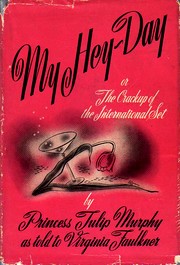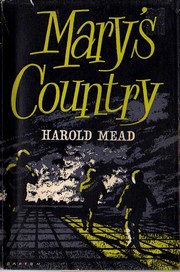Life does get in the way of one’s hobbies at times. NeglectedBooks.com has had to suffer the fate of its subjects since mid-December, and even now I fear this post will have to be more telegraphic than usual–if I can manage that. I have to side with Pascal in believing that it takes longer to write less.
Here, at least, is a recap of recent rediscoveries:
- Mary’s Country, by Harold Mead
London: Michael Joseph, 1957 - I learned of Mary’s Country when browsing through the archive of Ken Slater’s “Something to Read” columns from Nebula Science Fiction. Slater gave the novel a big thumbs-up, writing, “All in all, whilst this may not be the happiest book of the moment, it is by far the most interesting and the most powerful. Highly recommended for a one-sitting reading. Don’t start it until you have the time to finish it . . . it is dangerous!”
Had 1984 and Lord of the Flies not been published within the decade prior to Mary’s Country, Slater might have been justified by adding that it was the most original novel of the moment. Unfortunately, anyone familiar with them would find it hard not to view Mead’s work as a mash-up of the two books. The novel opens in a state not unlike that in 1984, in which a ruling class keeps a prole-like population in check through drink, prostitution, and cheap entertainment while waging war against the hated “Dems”. As part of its master plan, the state is practicing a form of eugenics, separating out the finest physical specimens at birth and raising them to be future rulers.
Mary’s Country follows a group of such children as they watch the state collapse around them through the effects of biological warfare. After all their masters and many of their classmates have died, they band together and trek to an unknown paradise that Mary, one of the older children, has described to them. Unfortunately, as disease and chaos has destroyed their civilization, they are forced to arm themselves and fight off other bands of survivors. As they trek into the countryside, their means and moraes grow more primitive, and they adopt a totem they dub “the Watchman”. Here shades of Lord of the Flies can be seen as a new, more violent, tribal culture emerges.
Mary’s Country is certainly a powerfully-written book, and I found myself drawn by its strong narrative. But I would be hard-pressed to recommend the book for republication when ignorance of Golding and Orwell would have to be a pre-requisite for any reader hoping to experience its full effect.
- The Dogs, by Ivan Nazhivin
Philadelphia: J.B. Lippincott & Co, 1931 - Nazhivin’s novel is a panorama of Russia from before World War One to the height of the Russian revolution as seen through the eyes and minds of dogs. The dogs mirror society, ranging from a pair of noble Borzois and the pampered lapdog of the Grand Duke Nicholas’ mistress to Siedoi, a mutt. Despite his questionable pedigree, Siedoi is the novel’s protagonist, and manages to travel from Moscow to the country estate of a family of Russian gentry to the trenches on the Eastern Front and a prisoner-of-war camp in Austria and then back again to the estate as the human society around him progressively collapses.
Time magazine’s review of The Dogs called it, “one of the most articulate books of Russia, of human and other natures, yet written in the Tolstoi vein,” and like Tolstoi, Nazhivin displays a remarkable ability to portray his characters–both dog and human–in all their faults without passing judgment. With one exception: Peter, whom we first see as a lax and cruel kennel keeper, then as a thief, liar, coward, cheat, rapist, and, finally, Bolshevik rabble-rouser. Though Nazhivin doesn’t gloss over the problems and corruptions of Tsarist Russia, it’s clear that Peter symbolizes all the evils brought by the Communists, and the only thing lacking in the caricature are horns and a tail.
Still, The Dogs is moving account of the destruction experienced at all levels of Russian society enhanced by the novelty and humor of being told from animal perspectives. And in the much-travelled Siedoi, a flea-ridden survivor with a romantic soul, Nazhivin creates one of most memorable characters I’ve come across recently.

- My Hey-Day, or The Crack-up of the International Set, by Princess Tulip Murphy, as told to Virginia Faulkner
New York: Duell, Sloan, and Pearce, 1940 - This book is pure froth–but it’s premium-quality froth. These are the purported memoirs of Princess Tulip Murphy, whose nobility is not the only thing about her of questionable provenance. After leaving her husband, “Brick-a-minute” Murphy, she manages through a combination of theft, seduction, and blackmail–though none of these offenses is so crudely named by their culprit–to elbow her way into “the International Set.” She then circulates among this amorphous band of royalty, heirs, heiresses, and hangers-on from Bajden-Baden to Cucamonga.
Each chapter recounts her adventures in a new place–Stockholm, where she meets Xerxes IX, Crown Prince of Jugo-ourway and his mother, Queen Carmen-Veranda; England, where she spents a dreary week at Sneers, the Spiltshire seat of the Earls of Quinsy; Pompei, where she takes her turn watching the famous painter, Pablo Paolo Pali at work on his prize-winning composition, “There Are More Ways of Choking a Cat than by Swallowing It With Butter, Horatio”; Mazatlan, where her friends Peter Frenzy Fripp and Olga Ostrogoth are tossed in jail for photographing an execution (“Nobody we knew,” the Princess hastens to add). Each spot offers her a chance to air yet more of her remarkable wardrobe:
I was wearing an original DeClassé of spaghetti-colored cambric, handsomely trimmed in gum-drop green duvetyn with shoulder-knots of solid tinsel. My hat was a saucy beret no bigger than an aspirin tablet, which was held to my head by a specially trained family of matching chameleons. My only jewelry, square-cut cultured emerald cuff-links, matched the duvetyn, and I carried a fish-net parasol which could also be used for water-divining.
As the world edges closer to the outbreak of World War Two, her trek eventually leads her to a yurt in forbidden Tibet, where despite the company of Lulu Alabaster, Lady Crystal Scum, and Count Udo von und zu Vonundzu, and heated political debates (“You know as well as I that Germany is dictated–but not red,” observes the Count), she finds herself bored: “But to the teeth!” Even though “there are so many armies wandering around that trains and ships are said to be unpleasantly crowded,” she resolves to head off in search of the “European belligerents”: after all, she notes, “Everyone’s going.”
As Time magazine wrote of Faulkner’s first novel, Friends and Romans, My Hey-Day “… breaks nobody’s bones or butterflies, lets no threatening skeletons loose on a frightened world, hurls no manifesto, literary or political.” What it does is offer a steady stream of wise-cracks, puns, and other comic material that holds up remarkably well considering the many decades passed since it last saw the light of day.


Just glad you’re back. I was starting to think that we had another ghost blog on our hands.
Over at GoodReads.com, Kay lists “My Hey-Day” in a delightful list of “faux memoirs” that includes other such neglected gems as “The Autobiography of Augustus Carp, Esq.” and “The Life and Death of Rochester Sneath”:
http://www.goodreads.com/review/list/241691?view=reviews